A Dragon Island Near Tokyo! Enoshima Shrine: Features and Highlights

Enoshima Shrine, located in Enoshima, an island off the Shonan coast just south of Tokyo, is famous as one of Japan’s Three Great Benzaiten Shrines. This article will introduce the highlights of Enoshima Shrine.
Enoshima Shrine is located in Enoshima, Kanagawa, and is a high-status shrine ranked as one of Japan’s Three Great Benzaiten Shrines. Benzaiten is widely worshiped as a goddess of entertainment and economic fortune. The other two of the Three Great Benzaiten Shrines are Hiroshima’s Itsukushima Shrine and Shiga’s Tsukubusuma Shrine.
Other gods aside from Benzaiten are also enshrined at Enoshima Shrine. They are the three goddesses born between the Japanese mythological gods Amaterasu-omikami (*1) and Susanoo-no-Mikoto (*2). These three goddesses are enshrined at their respective yashiro (*3) by the name of Hetsumiya, Nakatsumiya, and Okutsumiya.
*1 Amaterasu-omikami: Japanese goddess believed to have governed the heavens.
*2 Susanoo-no-Mikoto: a Japanese god; Amaterasu-omikami’s younger brother.
*3 Yashiro: a building that serves to enshrine a god.
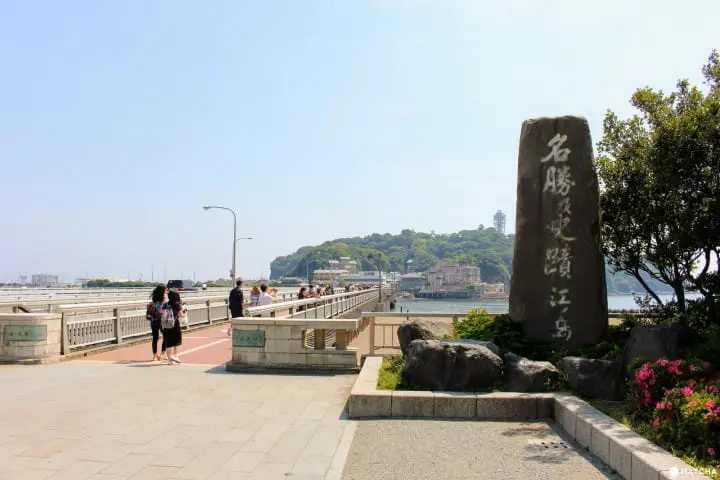
Upon arriving at Enoshima, you will see the Enoshima Benten Bridge. This bridge (389 meters long) was constructed for the Tokyo Olympics sailing competition held in 1964. The ocean extends along either side of the bridge, allowing you to watch people as they enjoy marine sports.
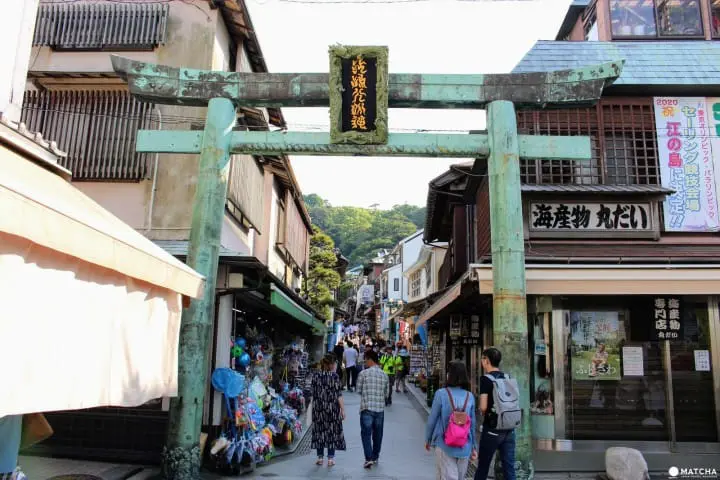
You will see blue-green torii gates once you cross the bridge. These are called bronze torii gates and are the entrance to Enoshima. As you continue past the gates, you will be in the shrine shopping district where souvenir stores line the extremely lively streets.

After walking two, three minutes past the bronze torii gates, in contrast, you will find these vibrant vermilion torii gates come into view. True to its appearance, these gates are called the vermilion torii gates.
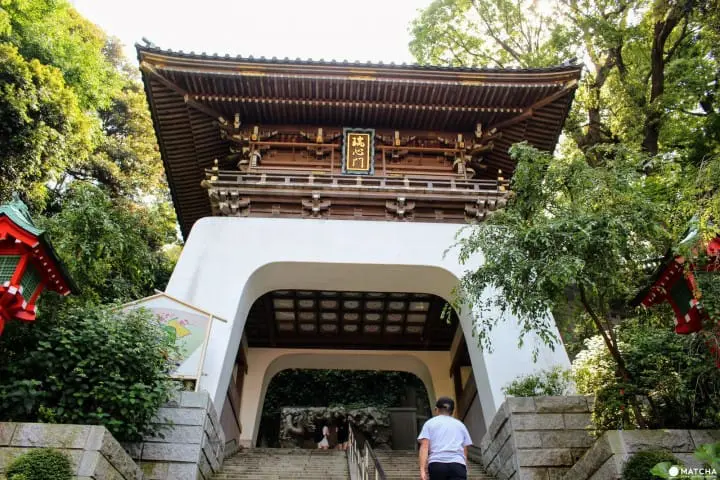
Past the vermilion torii gates and up a flight of stone steps is the Zuishinmon. These gates were modeled after the Ryugu-jo (*4) and it seems to be named as such so that visitors can visit to refresh their minds and spirits.
Don’t miss the artistic paintings of lions and mouton peonies drawn on the walls and ceiling. These lion paintings represent a prayer that protects the enshrined deities and prevents calamity from falling upon their worshipers.
*4 Ryugu-jo (Palace of the Dragon King): the palace of the sea god located underwater that appears in the famous Japanese legend "Urashima Taro".
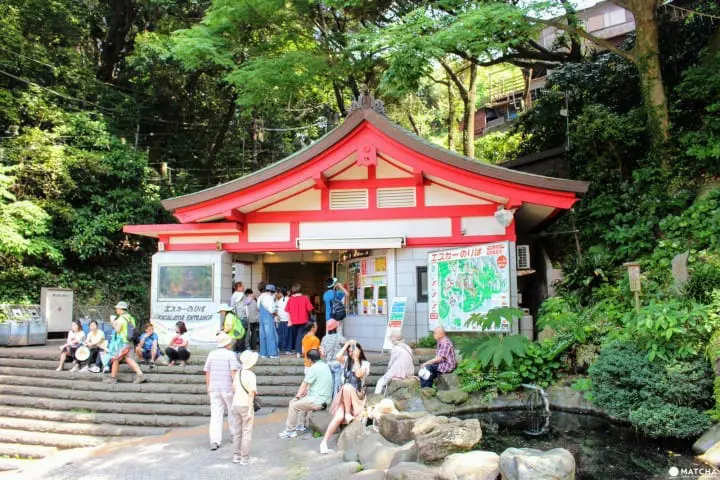
For those who have difficulties climbing the stone steps, how about utilizing ESCAR? ESCAR is a paid escalator; it is 360 yen for adults and 180 yen for children.
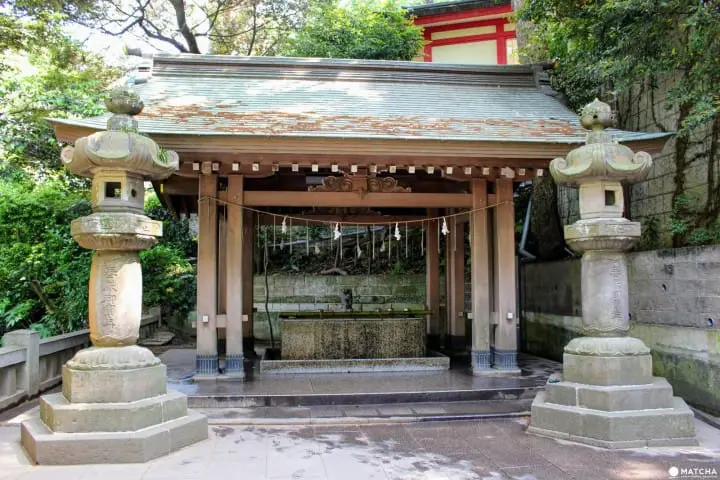
About one or two minutes away from the Zuishinmon is the temizuya where visitors cleanse their minds and bodies. Fill the ladle (hishaku) with water and cleanse your left hand, right hand, and mouth in that order.
Hetsumiya

This is Hetsumiya. It is where Tagitsuhime-no-Mikoto is enshrined. Amongst the Shinto precincts on Enoshima, an island with uplands, Hetsumiya is situated at the lowest elevation and is also called Shimonomiya. As it is located nearby the island’s entrance, most prayers are offered here. You can sense the sacred atmosphere while surrounded by the forest.
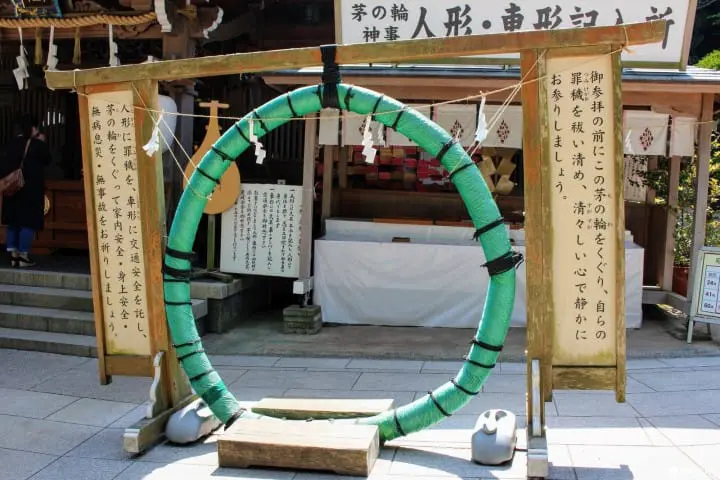
To the right of the building is the chinowa. This object is used to cleanse your mind and body; pass through this ring before praying and it shall remove your wrongdoings and impurities.
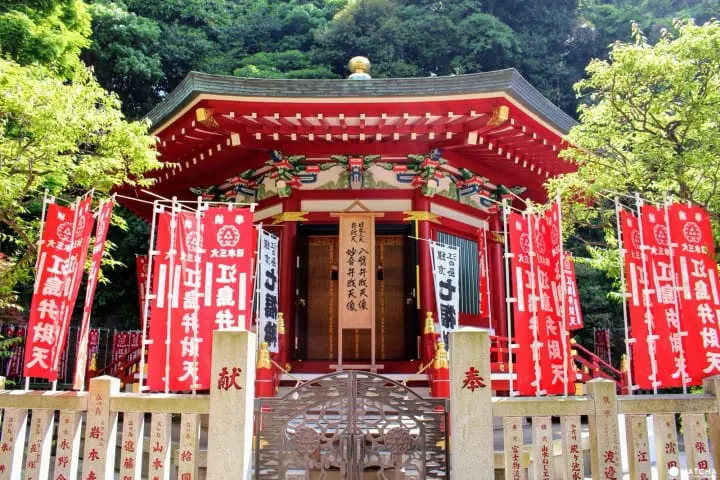
To the left of Hetsumiya is a Ho-an-den. This is where the Eight-Armed Benzaiten, designated as one of Kanagawa’s Important Cultural Properties, and the nude Myo-on Benzaiten, one of Japan’s Three Great Benzaiten, is enshrined. Pay the entrance fee at the nearby shrine office.
Nakatsumiya

Walk five minutes from Hetsumiya and you will arrive at Nakatsumiya where Ichikishimahime-no-Mikoto is enshrined. You will find a pair of stone lanterns that were offered to the shrine by the Edo-period kabuki theaters Ichimura-za and Nakamura-za as well as the hand prints of kabuki actors along the shrine road. The building is a vivid vermilion color thanks to its extensive repairs completed in 1996.
Okutsumiya

Lastly, there is Okutsumiya, where Tagirihime-no-Mikoto, the eldest of the three goddess sisters, is enshrined. She is said to be a goddess that peacefully protects the sea. When you face towards Okutsumiya, there is a garden lantern to the right that depicts Otohime (*5), a character that appears in the Japanese legend and is said to live in the Ryugu-jo, while to the left there is a lantern that depicts Urashima Taro (*6) riding a turtle.
*5 Otohime: the princess that appears in the legend "Urashima Taro". The sea god’s daughter; she is believed to live in the underwater castle Ryugu-jo.
*6 Urashima Taro: Tthe protagonist of the legend "Urashima Taro"; it is said that he visited the Ryugu-jo by riding a turtle.

Drawn on the ceiling of the front shrine is the All-seeing Turtle. He is drawn so that he is always staring at you no matter what angle you look at him from.
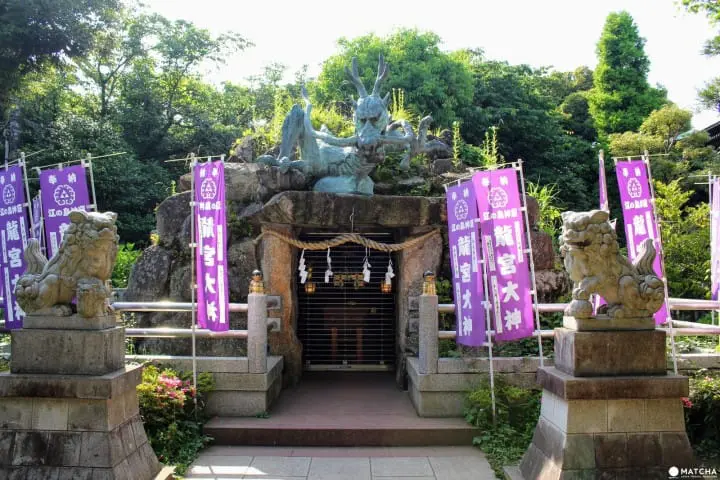
Next to Okutsumiya is Wadatsumi-no-miya where Ryujin, the dragon god, is enshrined. A festival is held annually on September 9th. It is believed that this is where Ryujin took up residence when Enoshima became an island.
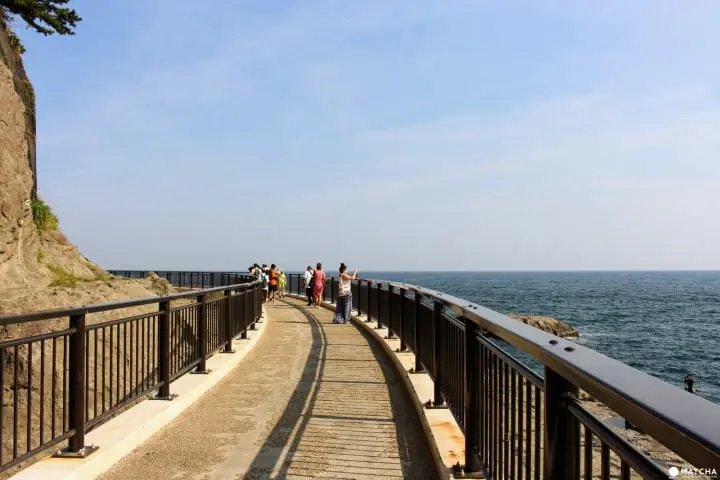
You will arrive at a cave called Iwaya after a ten-minute walk from Okutsumiya. It has been said that many high priests and military commanders have visited the cave to pray for the fortunes of war, health, and peace.
In Conclusion
You will find yourself coming full circle on Enoshima after going around Enoshima Shrine. “I want to know more about Enoshima!” - if that’s what you’re thinking, then please try visiting Enoshima Shrine.
旅行が好きです!取材を通して、自分自身、日本の魅力を発見していきたいです!



































![[Coupon Available] Attention Overseas Winter Sports Fans! Nagano's Sports Depot Has Evolved](https://resources.matcha-jp.com/resize/720x2000/2026/01/05-254819.webp)
![[2 hours from Tokyo ] 10 Quiet and Breathtaking Views of Mount Fuji in Yamanashi Hokuto City , Yamanashi - Part 2](https://resources.matcha-jp.com/resize/720x2000/2025/12/16-253037.webp)

![[Reopening in March 2026] Ikoma Sanjo Amusement Park Park, 45 minutes from Osaka , with free admission](https://resources.matcha-jp.com/resize/720x2000/2024/08/28-194409.webp)